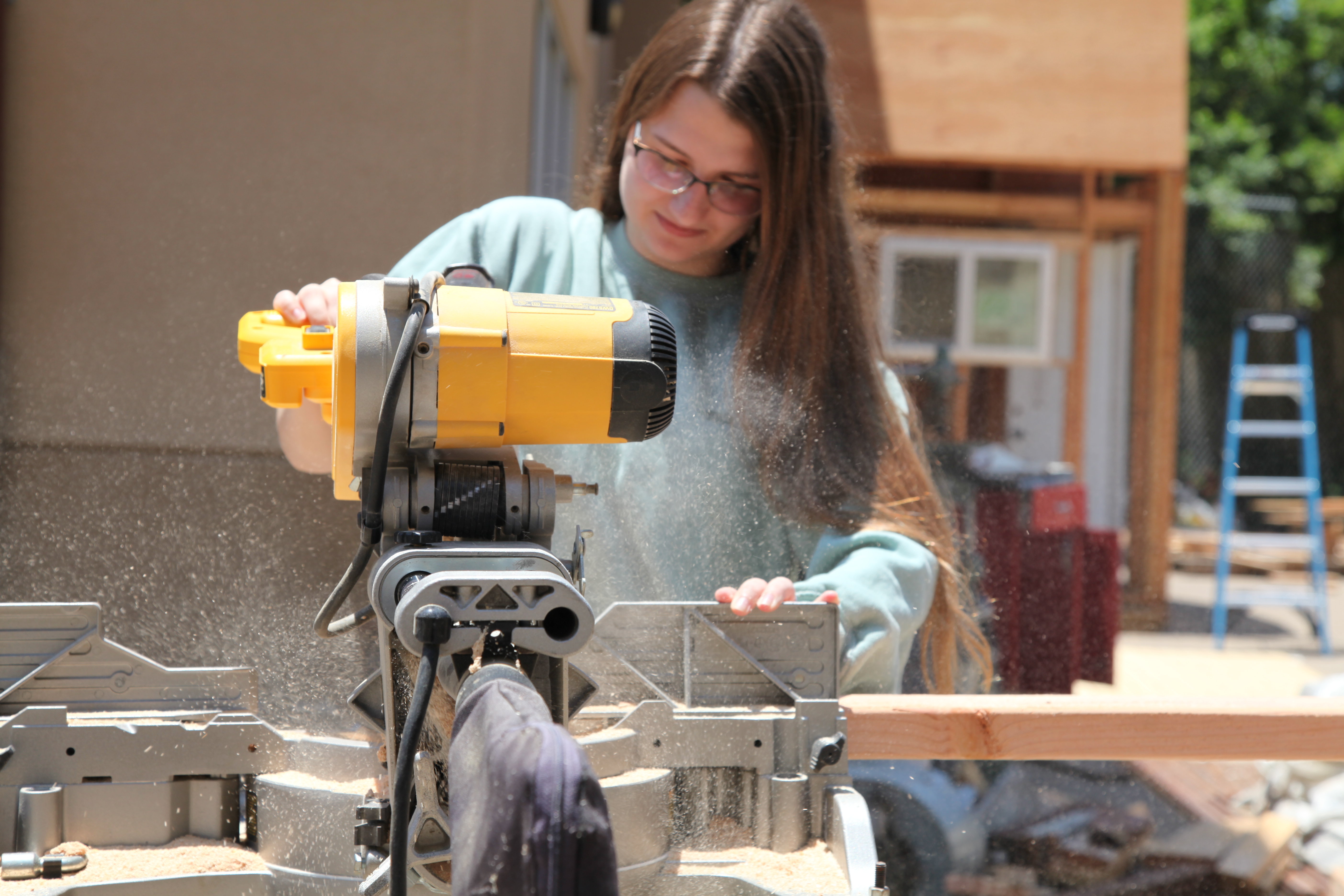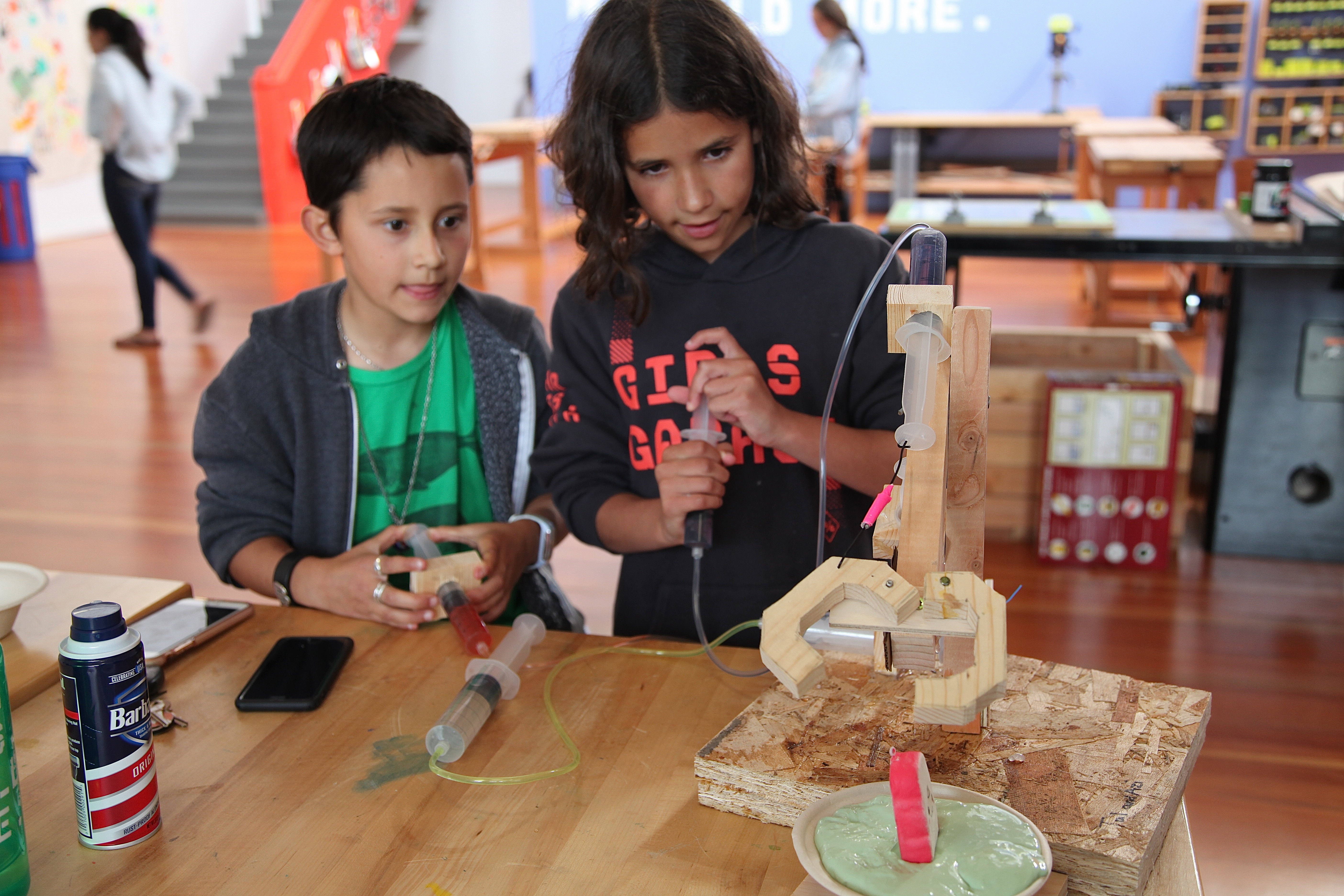This story was produced in collaboration with the Hechinger Report.
High school auto mechanics teacher Kristina Carlevatti knows what it’s like to be one of just a few females in a class. That was her frequent experience while earning a degree in technical and trade education at the State University of New York–Oswego.
“There was the sense that you were being judged, like you didn’t know what you were doing, so the guys might try to help you or hit on you,” she says.
Carlevatti has been teaching auto repair for six years now at Myers Park High School in Charlotte, North Carolina, where a booming automotive industry has produced plenty of jobs. Boys dominated the shop courses until Carlevatti started an all-girls Intro to Auto class this past school year.
When only co-ed trade classes were offered at the school, Carlevatti would see one or two girls at most. But Intro to Auto filled up quickly, drawing 16 girls.
Girls-only trade classes like Carlevatti’s are gaining traction, and the timing couldn’t be better. A shortage of skilled workers is driving up wages in the trades, especially in traditionally male-dominated professions such as auto repair, construction, and welding. (Nationwide, only 2 percent of auto mechanics, 3 percent of construction workers, and 4.5 percent of welders are women, according to the Bureau of Labor Statistics.) High schools like Myers Park have found that, when they offer female-only trade courses, the girls sign up.
The trouble is, such courses could run afoul of Title IX regulations regarding single-sex education. The law prohibits separation of genders in vocational training. Still, advocates see plenty of reason to forge ahead, and the labor shortage is just one factor. They argue that all-girls trade classes embolden girls to push against gender stereotypes that threaten to hold them back, whether they want to swing a hammer or break into the boardroom. Shop class, it seems, is a new path to female empowerment.
Evelyn Harris, who just finished her junior year at Myers Park, says she never considered taking an auto course until Carlevatti’s class. But once she started, something clicked. “This is my kind of class,” she says. “I like the hands-on work, getting oily and greasy, showing the guys I can do what they do.”
For Harris, there’s another advantage. The class, she says, has become a sisterhood of sorts: “We all learn together and teach each other. It’s not a competition.”
That sense of bonding appears to be common among students in single-gender classes, according to Rosemary Salomone, professor of law at St. John’s University and author of the book Same, Different, Equal: Rethinking Single-Sex Schooling. Salomone says that, while some studies have shown that single-gender classes don’t improve academic achievement for males or females, there is evidence to support modest claims of benefits in less quantifiable areas, such as self-esteem, belonging, and motivation.
Yet Salomone, who helped draft the Department of Education’s 2006 Title IX regulations for single-sex public education, says she questions the legality of girls-only shop classes. The regulations allow the use of federal dollars only for single-gender classes in academic subjects such as math and engineering. Vocational classes have generally been prohibited from separating genders, Salomone says, because of the history of schools channeling girls into lower-paying technical fields.
Salomone says she’d like to see the regulations changed to permit all-girls classes in traditionally male trades. But she stressed that these classes would have to be voluntary, and schools would have to offer all-boys’ as well as co-ed options to satisfy the Title IX requirements of “substantial equality” and evenhandedness.
For the time being, concern about violating Title IX may prevent some schools from experimenting with single-gender classes. That was the case at Oregon’s Sherwood High School, where in 2015 the principal canceled the school’s popular all-girls welding class, No Boyz Allowed, because he decided it did not comply with the law.

(Photo: Brenda Iasevoli/the Hechinger Report)
Schools that are offering all-girls shop classes are either unaware of Title IX’s ins and outs, or they assume the classes comply with current regulations since the courses often have an academic, non-vocational purpose, such as teaching math or engineering concepts. This could be why, to date, they haven’t caught the eye of regional Title IX coordinators.
The all-girls construction class at Abraxas Continuation High School in Poway, California, is an example of a trade course whose lessons extend well beyond typical building work. Last year, the girls cut and assembled pipe for a hydroponic filtration system. (Hydroponics refers to a method of growing plants without soil.) The students engineered the whole system using science and math skills, along with muscle. A network of pipes now carries fish excrement filtered from a pool of 300 classroom-bred tilapia to the school garden, where vegetables such as butterhead lettuce, cucumbers, and kale grow. The system is so efficient that the school says it is able to donate 300 heads of lettuce a week to families in need.
The girls’ success showed what they could do with a little elbow grease and a lot of problem solving, and it deepened their camaraderie, according to Alana Johnson, an 18-year-old who recently graduated. It helped, she says, that the students could work without the distraction of “super loud guys” who tend to get “way too rowdy.”
Now that Johnson has tackled mixed-gender advanced construction courses, she feels confident enough to help her mom take on small plumbing jobs like replacing a part on the toilet or just hanging pictures around the house. “We somehow automatically think of construction and plumbing as a guy’s thing,” says Johnson, who is entering a nursing program in the fall. “But these are things everyone should know how to do regardless of gender.”
For Caitlin Pierce, who just completed her junior year, the work was a revelation. “When I first used a hammer, it was so loud, I felt like I was doing something wrong,” she says. “But watch a boy pick up a hammer for the first time, he’ll swing as hard as he can.”
After mastering power tools, Caitlin, a generally quiet student, found that she enjoyed supervisory roles—carrying a clipboard and making sure the girls got the job done. While she has no plans to go into construction after high school, preferring instead the quiet atmosphere of a library, she’s grateful that construction helped her discover a new skill. “I’ve learned how to make myself heard,” she says.
Yet high school may be too late to challenge ingrained gender stereotypes, and some educators want to tackle preconceptions much earlier. That’s why, in 2016, environmental designer Emily Pilloton started the non-profit Girls Garage with an aim to encourage nine- to 17-year-old tinkerers in Berkeley, California.
Pilloton was inspired to start the organization because of what she calls “totally unacceptable” moments she witnessed during her years as a high school and college instructor. In one class she taught at the University of California–Berkeley, a male and female student were paired up to cut cedar fence board. “The girl said to the guy, ‘You do it, you’re the boy,'” Pilloton recalls. “The guy didn’t know how to use a saw either, but she assumed he did.”
Girls Garage teaches welding, building, and other skills to girls after school and over summer vacation. These workshops aren’t free, but students can apply for scholarships. Girls Garage doesn’t receive federal funding, so it isn’t subject to Title IX restrictions.
At a recent workshop, students tested a mechanical arm they had built to see if it could grab a squishy toy out of a bowl of slime. The task required woodworking and engineering skills.
Fifth-grader Tal Betser, 11, says she liked that her instructors trusted her to use a power tool. “They let you use the tools and saws and they step back,” she says. “They’re not just always trying to keep you safe.”
Tamsin Levy, whose nine-year-old daughter, Azi, took the class, says it’s important to have all-girls spaces where kids can get their hands dirty and solve problems. Azi can be “hard to engage,” she says, but in Girls Garage, she’s always focused.
For her part, Azi, who previously took a welding class at Girls Garage, says she found it satisfying to “make something that functioned.”
Instructor Allison Oropallo says that at Girls Garage she has that rare experience of working with females who actually do what she does. And while it’s important for girls to see females teaching these classes, she says, it’s equally important for boys to learn a trade from a girl.
Oropallo also teaches a co-ed industrial arts course at Terra Linda High School in San Rafael, California. She says many students take her class because it looks good on college applications. “For me, what’s important is to see a kid say, ‘This was impossible to build,’ but she did it anyway. She figured it out. We’re not trying to turn kids into construction workers.”

(Photo: Brenda Iasevoli/the Hechinger Report)
But some teachers are encouraging their female students to pursue blue-collar professions, not just for empowerment, but as careers.
“Right now there are super-good opportunities for females to get into a trade and make a heck of a living off of it,” says Kyle Chalupsky, who has taught an all-girls construction class at Two Harbors High School in northern Minnesota for the past five years. “The days where blue-collar workers don’t make money are over. I have a master’s degree, but kids who go into trades make more money than I do.”
Chalupsky says that as employers in the construction trades seek to add diversity to their workforces, they are particularly eager to hire women and underrepresented ethnic minorities.
Every year, the all-girls class at Two Harbors fills to capacity. Using tools ranging from measuring tape to table saws, students frame walls and build canoes and storage sheds. “They feel more comfortable doing this type of work, not so self-conscious, and they don’t get overrun by the boys,” Chalupsky says. “There’s no chance a boy will say: ‘Get out of the way. I’ll do that.'”
Yet even as the number of these courses grows—and if Title IX does not discourage that growth—it could be a while before women turn to traditionally male-dominated trades in large numbers. Women still tend more toward caregiving jobs, such as nurse’s or teacher’s assistants, even though they often don’t pay a living wage, says Nicole Smith, chief economist at the Georgetown University Center on Education and the Workforce.
“Go where the boys are,” Smith tells students. “That’s where the money is.”
Nurse’s assistants and teacher’s assistants, 90 percent of whom are female, earn a yearly median wage of $27,510 and $26,260, respectively. By contrast, welders, 95 percent of whom are male, earn a yearly median wage of $40,240, according to the Bureau of Labor Statistics.
For many women, putting on a hard hat or even a pair of safety goggles remains a big leap. But Smith says that girls-only career and technical classes are a start. “These aren’t men’s jobs, these are people’s jobs. Luckily, there are a lot of pioneers out there putting on the boots and doing what they need to do.”
This story was produced in collaboration with the Hechinger Report, a non-profit, independent news organization focused on inequality and innovation in education.





